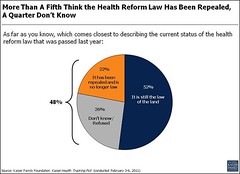| Internal Revenue Service (IRS) (Photo credit: cliff1066™) |
A 2011 MBO Partners study found that about 16 million workers were classified as independent contractors and predicted an even greater use of independent contractors in the next 10 years. After all, independent contractors are about 30% cheaper than employees and come without many burdensome employment rules compelling incentives for businesses. A 2000 Department of Labor (DOL) study revealed that 10% to 30% of all employers misclassify workers. In 2008, the IRS found that even when workers and employers asked the IRS for proper classification
| English: logo of MBO Partners (Photo credit: Wikipedia) |
What is the government’s stake in correctly classifying workers? The IRS knows that it is easier to keep employees compliant than independent contractors. The latest IRS tax gap study shows that Form W-2 employees misreport only 1% of their income, while, on average, independent contractors misreport 8% of their income. For the IRS, employee status means more automated, less expensive post-filing compliance activity, such as underreporter notices. Employee status is even more important in light of the Patient Protection and Affordable Care Act (PPACA), P.L. 111-148, which mandates that employers with at least 50 full-time employees provide health care insurance or pay a stiff penalty. The mandate goes into effect in 2014, but employers may
| Kaiser Family Foundation Affordable Care Act Poll (Photo credit: Vince_Lamb) |
Traditionally, the IRS has used the 20 common law factors found in Rev. Rul. 87-41 to test whether a worker is an independent contractor or an employee. Over the years, the IRS has tried to simplify determinations without much success. To complicate matters further, since 1978, IRS worker reclassification efforts have been hampered by defenses under Section 530 of the Revenue Act of 1978, which provided employers with safe harbors, such as reliance on a prior IRS audit or a long-standing industry practice. As a result, reclassification audits often led to long disputes in IRS appeals offices. To combat the enforcement stalemates, in 1996, the IRS instituted an early resolution program that could be used to settle audit disputes.
The Classification Settlement Program (CSP) allowed for prospective treatment of workers as employees but limited the taxes owed due to reclassification. In 2011, the IRS began the Voluntary Compliance Settlement Program (VCSP), which allows an employer to seek prospective treatment for workers and pay even less than under the CSP arrangement, but the program is purely voluntary. It is not available for taxpayers in an employment tax audit conducted by the IRS, DOL or state agencies. Since the program started, the IRS has received only 625 applications, according to officials at the 2012 Carolinas Tax Forum, held Aug. 8–10 in Charlotte, N.C.
Article by Jim Buttonow – cpa2biz.com – September 26, 2012
Related articles










No comments:
Post a Comment